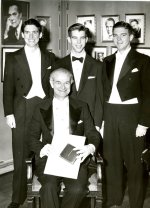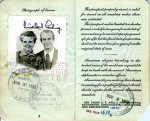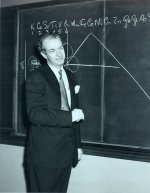
Proteins, Passports, and the Prize (1950-1954)
1950
On February 13, Pauling speaks to a large audience in Carnegie Hall in New York City, protesting President Truman’s decision to produce the hydrogen bomb. His speech is subsequently published in a brochure entitled "The Ultimate Decision."
In May, the National Science Foundation comes into being (such a foundation was a major recommendation of "Science, the Endless Frontier", the Bush Report on which Pauling worked).
Pauling publishes College Chemistry, a more popular treatment of basic chemistry than his General Chemistry. It, too, is a great success and passes through three editions.
Pauling and Corey publish a short note, "Two Hydrogen-Bonded Spiral Configurations of the Polypeptide Chain," in JACS. They describe two configurations, the alpha helix and the gamma helix, of the arrangement of atoms in proteins.
On September 7, Sidney Weinbaum is convicted in Federal District Court of having committed perjury by saying that he had never been a member of the Communist Party when he was questioned in 1938 by a United States Army Intelligence Officer. Pauling had collected money for a defense fund to help defray Weinbaum’s legal fees.
On November 13, Pauling, testifying before the Senate Investigating Committee on Education of the State of California, explains for over two hours why he objects to loyalty oaths involving inquiry into a person’s political beliefs.
![Crellin and Ava Helen Pauling, Elizabeth Bond [Ava Helen's aunt], Peter and Linda Pauling, 1940s. Crellin and Ava Helen Pauling, Elizabeth Bond [Ava Helen's aunt], Peter and Linda Pauling, 1940s.](../images/194-i.4-150w.jpg)
Crellin and Ava Helen Pauling, Elizabeth Bond [Ava Helen's aunt], Peter and Linda Pauling, 1940s.
LP Photographs, 194?i.4
1951
On February 28, his fiftieth birthday, Pauling communicates "The Structure of Proteins: Two Hydrogen-Bonded Helical Configurations of the Polypeptide Chain," to PNAS. This paper, which was written with Corey and H.R. Branson, appears in April.
On May 15, PNAS publishes a series of papers on protein structure written by Pauling and various collaborators. The managing editor of the journal calls this series of seven articles "the scientifically most distinguished of the first fifty volumes" of the journal. In what is essentially a small monograph on the structure of proteins, Pauling gives a detailed account of both the alpha and the gamma helix, with atomic coordinates and structure factors for these two configurations (the alpha is a 3.7-residue helix and the gamma is a 5.1-residue helix). He also describes the pleated sheet, a new layer configuration of polypeptide chains, and he discusses the structure of collagen and hemoglobin. Pauling’s achievement is reported in magazines and newspapers all over the world.
During the summer, Pauling experiences difficulties in getting a passport to attend meetings in Europe, but he is eventually given a passport.
In the summer, the United States Public Health Service turns down Pauling’s request for a $40,000 grant for blood and protein investigations on "loyalty grounds."
During the first week in September, Pauling participates in the Diamond Jubilee Meeting of the American Chemical Society in New York City. His work is discussed in sessions on hemoglobin, bond strengths, and protein structure.
In the fall, the so-called "resonance controversy" continues when the Chemical Sciences Division of the USSR Academy of Sciences attacks Pauling’s resonance theory of chemical bonds as "pseudoscientific," "vicious," and an example of a world-outlook "hostile to the Marxist view."
In October, Edwin M. McMillan wins the Nobel Prize in Chemistry for his work on the transuranium elements (McMillan is the first of several Pauling students who will win the Nobel Prize).
1952
In February, Pauling receives a letter from Mrs. Ruth B. Shipley of the Passport Division of the Department of State, informing him that his request for a passport is being denied because "the Department is of the opinion that your proposed travel would not be in the best interests of the United States." Pauling had applied for a passport in January in order to visit England to take part in a meeting on the structure of proteins to be held on May 1. A debate was going on about whether his alpha helix really could be used to explain the structure of such proteins as alpha keratin, and the Royal Society was organizing a symposium to help resolve the differences about this important discovery.
The discovery by Pauling and Richard E. Marsh on the structure of chlorine hydrate opens a new chapter in the crystallography of water.
Throughout the summer, Pauling’s passport difficulties are constantly in the news. Senator Wayne Morse of Oregon publicly condemns the action of the State Department, as does Albert Einstein. Pauling makes a few more attempts to get a reversal, and on the "fourth try," he gets a "limited passport," good until October 1 for travel to England and France.
During July and August, Linus and Ava Helen Pauling make a six-week trip to France and England. In Paris, he attends the second International Congress of Biochemistry, and in England, he attends a meeting of the Faraday Society on the physical chemistry of proteins.
In the fall, he supports Adlai Stevenson, who is running on the Democratic ticket against the Republican, Dwight D. Eisenhower, who is elected president.
In the late fall, Pauling works out a structure for the nucleic acids. He submits his triple helix to PNAS on December 31 (it is published in February 1953).
1953
In January and February, Pauling and Corey make adjustments to their triple helix because the atoms are too tightly packed. James Watson, Francis Crick, Rosalind Franklin, and Maurice Wilkins in England think that Pauling’s model is wrong, and in February, Watson and Crick discover the double helix as the structure of DNA, which turns out to be correct.
Pauling and Corey publish "Stable Configurations of Polypeptide Chains" in the Proceedings of the Royal Society (London), an extensive summary account of their work on protein structure. It becomes one of the most heavily cited of Pauling’s publications.
Pauling sees Watson and Crick’s model of the double helix on a visit to Cambridge in April. He finds the structure surprisingly simple but beautiful.
Pauling publishes his theory of ferromagnetism in PNAS.
From September 21 to 26, a conference on the structure of proteins, which Pauling has organized, takes place at CIT. It is, in effect, a continuation of the discussions begun at the Royal Society meeting in May of 1952.
When, because of her political views, the American Chemical Society denies membership to Irène Joliot-Curie. Pauling, who regards Madame Joliot-Curie as a fine person and a great chemist, protests. He points out, to no avail, that news of her denial is creating ill will among French chemists.
In the fall, Pauling visits Israel in connection with memorial observances at the Weizmann Institute. This visit is part of a trip around the world that he and Ava Helen are taking. They spend six weeks in India and then a few days each in Rangoon, Bangkok, Hong Kong, Tokyo, and Honolulu.
1954
In January, the Rockefeller Foundation makes a conditional grant of $1,500,000 to CIT for research in chemical biology (the condition is that the Institute must match the Foundation’s grant in a period of three years). Pauling’s work on proteins, nucleic acids, immunochemistry, and disease in relation to molecular abnormalities will be supported.
On April 29, Pauling delivers the Harvey Lecture: "Abnormalities of Hemoglobin Molecules in Hemolytic Anemias."
In June, Pauling calls the suspension, as a security risk, of J. Robert Oppenheimer from his advisory activities with the Atomic Energy Commission "a disgraceful act on the part of the government of the United States." He finds this "display of ingratitude" toward one of the country’s most distinguished scientists unjustifiable by any rational argument.
In July, Pauling is refused a passport to leave the country. Prime Minister Jawaharlal Nehru had invited him to India for a dedication of an institute for scientific research.
In October, Linus Pauling learns that he has been awarded the Nobel Prize in Chemistry for "his research into the nature of the chemical bond and its application to the elucidation of the structure of complex substances."
Pauling is granted a passport (which had been most recently refused on October 1, but as one magazine put it: "Win a prize, get a passport").
Pauling and his family travel to Stockholm, Sweden, where, on December 10, Pauling receives his Nobel Prize from King Gustav Adolph VI.

Peter, Crellin and Linus Pauling Jr. with their father at the Nobel ceremonies, Stockholm, 1954.
LP Photographs, 1954i.57
Table of Contents
- The Ancestry of Linus Pauling (The Paulings)
- The Ancestry of Linus Pauling (The Darlings)
- Linus Pauling's Childhood (1901-1910)
- Linus Pauling's Adolescence (1910-1917)
- Pauling's Years as an Undergraduate at Oregon Agricultural College, Part 1 (1917-1919)
- Pauling's Years as an Undergraduate at Oregon Agricultural College, Part 2 (1919-1922)
- Linus Pauling as a Graduate and Postdoctoral Student at the California Institute of Technology, Part 1 (1922-1923)
- Linus Pauling as a Graduate and Postdoctoral Student at the California Institute of Technology, Part 2 (1924-1926)
- A Guggenheim Fellow in Europe during the Golden Years of Physics (1926-1927)
- Early Career at the California Institute of Technology (1927-1930)
- Pauling's Great Years of Achievement in Structural Chemistry, Part 1 (1931-1932)
- Pauling's Great Years of Achievement in Structural Chemistry, Part 2 (1933-1935)
- Pauling's Increasing Involvement in Molecular Biology (1936-1939)
- The War Years, Part 1 (1940-1942)
- The War Years, Part 2 (1943-1945)
- The Postwar Years, Part 1 (1946-1947)
- The Postwar Years, Part 2 (1948-1949)
- Proteins, Passports, and the Prize (1950-1954)
- Increasing Involvement in World Peace, Part 1 (1955-1958)
- Increasing Involvement in World Peace, Part 2 (1959-1963)
- The Center for the Study of Democratic Institutions (1964-1967)
- The University of California, San Diego (1968-1969)
- Stanford University (1969-1972)
- An Institute for Science and Orthomolecular Medicine, Part 1 (1973-1977)
- An Institute for Science and Orthomolecular Medicine, Part 2 (1978-1981)
- The Years Alone: Pauling after the Death of Ava Helen, Part 1 (1982-1988)
- The Years Alone: Pauling after the Death of Ava Helen, Part 2 (1989-1994)
- About the Author



